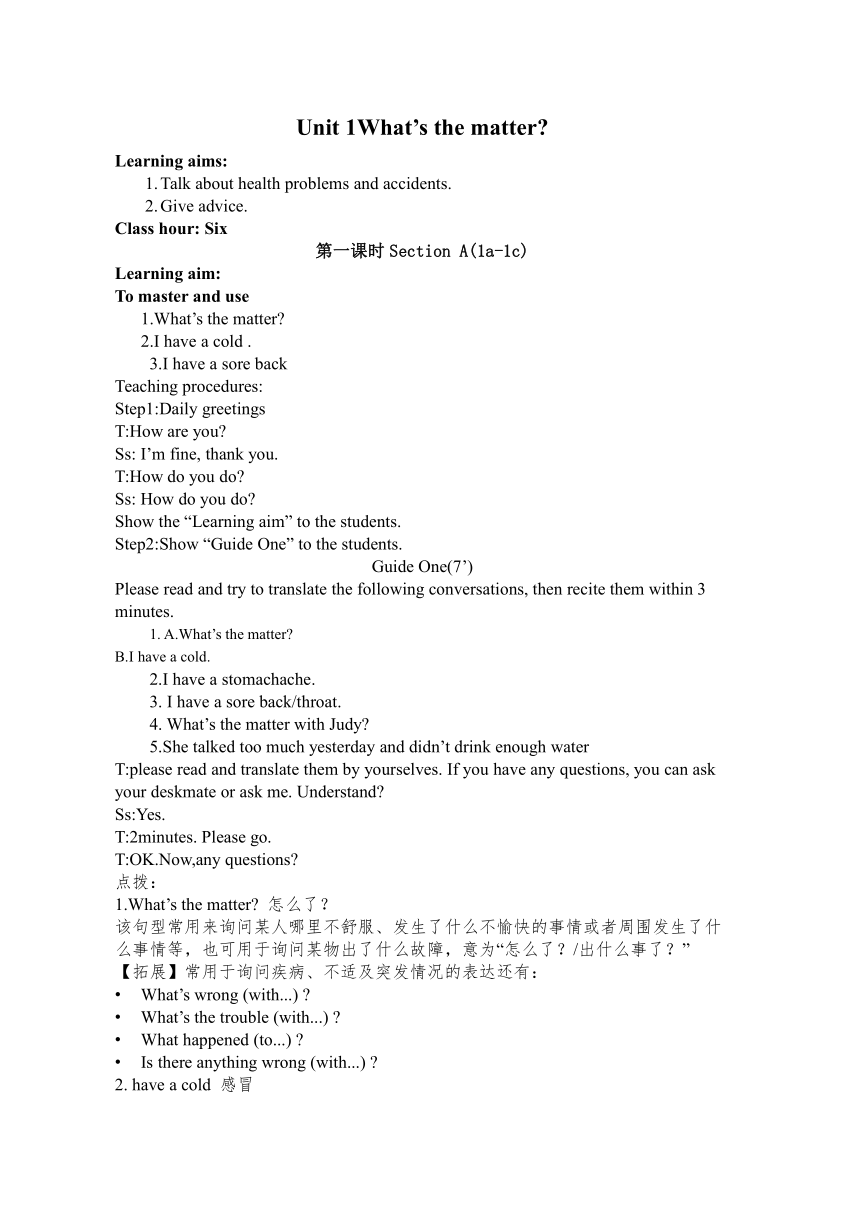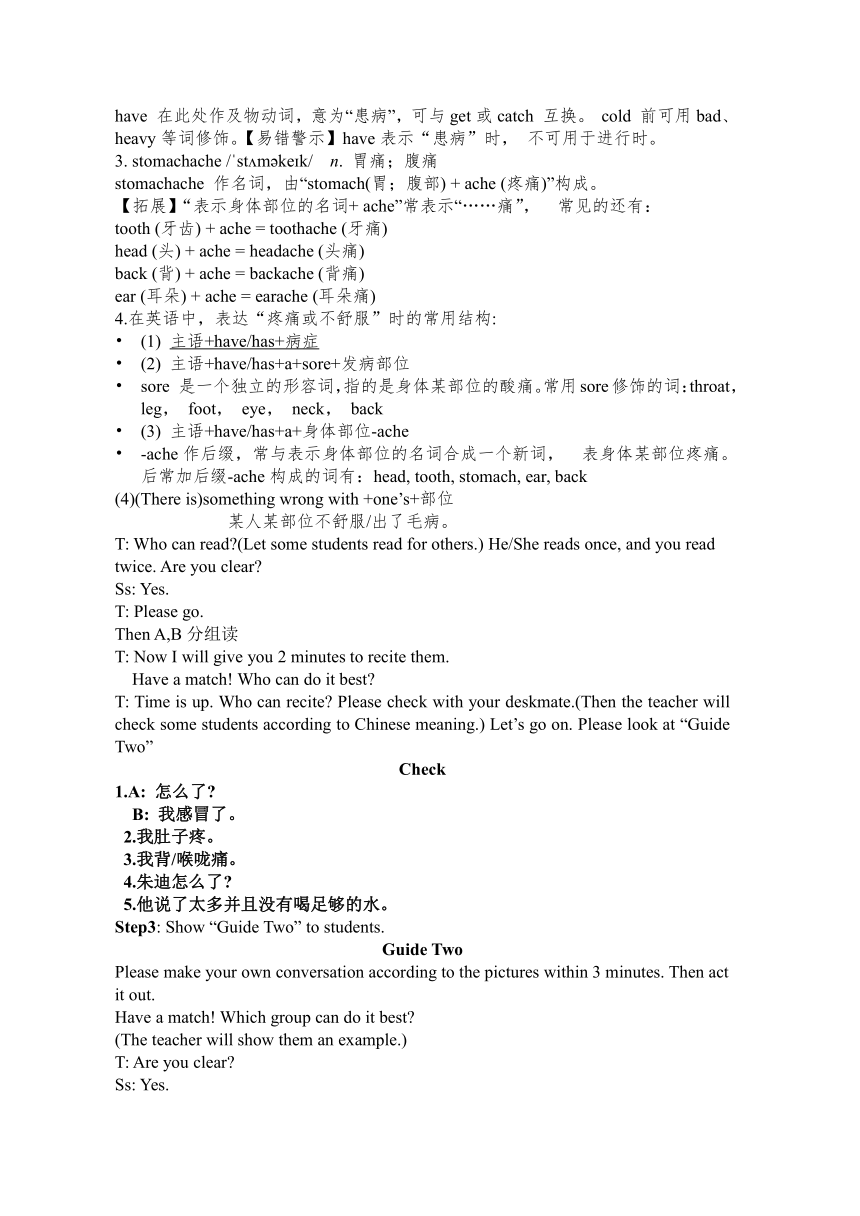2021-2022学年人教版八年级英语下册Unit 1 What's the matter?Section A(共2课时)教案
文档属性
| 名称 | 2021-2022学年人教版八年级英语下册Unit 1 What's the matter?Section A(共2课时)教案 |  | |
| 格式 | zip | ||
| 文件大小 | 21.8KB | ||
| 资源类型 | 教案 | ||
| 版本资源 | 人教新目标(Go for it)版 | ||
| 科目 | 英语 | ||
| 更新时间 | 2022-04-23 08:55:51 | ||
图片预览


文档简介
Unit 1What’s the matter
Learning aims:
Talk about health problems and accidents.
Give advice.
Class hour: Six
第一课时Section A(1a-1c)
Learning aim:
To master and use
1.What’s the matter
2.I have a cold .
3.I have a sore back
Teaching procedures:
Step1:Daily greetings
T:How are you
Ss: I’m fine, thank you.
T:How do you do
Ss: How do you do
Show the “Learning aim” to the students.
Step2:Show “Guide One” to the students.
Guide One(7’)
Please read and try to translate the following conversations, then recite them within 3 minutes.
1. A.What’s the matter
B.I have a cold.
2.I have a stomachache.
3. I have a sore back/throat.
4. What’s the matter with Judy
5.She talked too much yesterday and didn’t drink enough water
T:please read and translate them by yourselves. If you have any questions, you can ask your deskmate or ask me. Understand
Ss:Yes.
T:2minutes. Please go.
T:OK.Now,any questions
点拨:
1.What’s the matter 怎么了?
该句型常用来询问某人哪里不舒服、发生了什么不愉快的事情或者周围发生了什么事情等,也可用于询问某物出了什么故障,意为“怎么了?/出什么事了?”
【拓展】常用于询问疾病、不适及突发情况的表达还有:
What’s wrong (with...)
What’s the trouble (with...)
What happened (to...)
Is there anything wrong (with...)
2. have a cold 感冒
have 在此处作及物动词,意为“患病”,可与get或catch 互换。 cold 前可用bad、heavy等词修饰。【易错警示】have表示“患病”时, 不可用于进行时。
3. stomachache / st m ke k/ n. 胃痛;腹痛
stomachache 作名词,由“stomach(胃;腹部) + ache (疼痛)”构成。
【拓展】“表示身体部位的名词+ ache”常表示“……痛”, 常见的还有:
tooth (牙齿) + ache = toothache (牙痛)
head (头) + ache = headache (头痛)
back (背) + ache = backache (背痛)
ear (耳朵) + ache = earache (耳朵痛)
4.在英语中,表达“疼痛或不舒服”时的常用结构:
(1) 主语+have/has+病症
(2) 主语+have/has+a+sore+发病部位
sore 是一个独立的形容词,指的是身体某部位的酸痛。常用sore修饰的词:throat, leg, foot, eye, neck, back
(3) 主语+have/has+a+身体部位-ache
-ache作后缀,常与表示身体部位的名词合成一个新词, 表身体某部位疼痛。后常加后缀-ache构成的词有:head, tooth, stomach, ear, back
(4)(There is)something wrong with +one’s+部位
某人某部位不舒服/出了毛病。
T: Who can read (Let some students read for others.) He/She reads once, and you read twice. Are you clear
Ss: Yes.
T: Please go.
Then A,B分组读
T: Now I will give you 2 minutes to recite them.
Have a match! Who can do it best
T: Time is up. Who can recite Please check with your deskmate.(Then the teacher will check some students according to Chinese meaning.) Let’s go on. Please look at “Guide Two”
Check
1.A: 怎么了
B: 我感冒了。
2.我肚子疼。
3.我背/喉咙痛。
4.朱迪怎么了
5.他说了太多并且没有喝足够的水。
Step3: Show “Guide Two” to students.
Guide Two
Please make your own conversation according to the pictures within 3 minutes. Then act it out.
Have a match! Which group can do it best
(The teacher will show them an example.)
T: Are you clear
Ss: Yes.
T: 3minutes, please go.
(3 minutes later)
T: Time is up. Volunteers (Let some groups show their conversations.) You are very wonderful. Let’s go on. Please look at “Guide Three”
Step4: Show “Guide Three” to the students.
Guide Three(3’)
Look at 1a and finish it within 2 minutes.
Have a match! Who can do it best
Step5: Show “Guide Four” to the students.
Guide Four(3’)
Listen to the tape and finish 1b.
Have a match! Who can do it best
T: I’ll give you 2 minutes, please go.
Then check the answers.
Please look at our Class Exercises.
Step7: Class Exercise
Translation.
第二课时SectionA(2a-2d)
Learning aims:
1.To practice your listening.
2.To recite some important sentences and points.
Teaching procedures:
Step1:Daily greetings.
T:How are you
Ss: I’m fine, thank you.
T:How do you do
Ss: How do you do
Show the “Learning aim” to the students.
Step2:Show “Guide One” to the students.
Guide One(8’)
Look at 2d and find out the difficult points.
T:Please read and translate it by yourselves.If you have any questions, you can ask your deskmate or ask me. Understand
Ss:Yes.
T:2minutes. Please go.
T:OK.Now,any questions
点拨:
1.have a headache头疼
2. should的用法:
1). should是情态动词, 是“应该” 的意思 , 常用来表示劝告、建 议、认为某人应该做某事。
2). should 本身不能单独作谓语,必须和动词原形连用。
3). should 没有人称和数的变化,其否定形式为shouldn’t.
如:We should study hard.我们应该努力学习。
You shouldn’t play computer games.你不应该玩电脑游戏。
He should lie down and rest. 他应该躺下来休息。
3. have a fever 发烧
4.take breaks 休息
take a break
5.away from the computer远离电脑
Check
1.莉萨,你好吗
2.我头痛,并且脖子不能动。我该怎么办 我应该量体温吗
3.不,听起来不像是你发烧。周末你做什么了
4.我整个周末都在玩电脑游戏。
5.那很可能就是原因。你需要离开电脑休息几次。
6.是的,我想我是一个姿势坐得太久没有移动。
7.我认为你应该躺下休息。如果明天你的头和脖子还痛的话,就去看医生。
8.好的。谢谢,曼迪。
T: Who can read ( Let some students read for the others.) He/ She reads once .you read twice. Are you clear
T: Now I will give you 5 minutes to recite it. Are you clear 5 minutes later...
T: Time is up. Who can recite Please check with your deskmate. (Then teacher will check some students.) Let's go on.
Step3: Show “Guide Two” to students.
Guide Two(5’)
Look at 2a,Listen and number the pictures [1-5] in the order you hear them.
T: Are you clear
Ss: Yes.
T: OK, Let’s go.
Then check the answers.
Step4: Show “Guide Three” to the students.
Guide Three(3’)
Listen again . Listen again. Match the problems with the advice.
T: Are you clear
Ss: Yes.
T: OK, Let’s go.
Then check the answers.
Step5: Test(15’)
Please look at our Class Exercises.
Step6: Class Exercise
Translation.
Learning aims:
Talk about health problems and accidents.
Give advice.
Class hour: Six
第一课时Section A(1a-1c)
Learning aim:
To master and use
1.What’s the matter
2.I have a cold .
3.I have a sore back
Teaching procedures:
Step1:Daily greetings
T:How are you
Ss: I’m fine, thank you.
T:How do you do
Ss: How do you do
Show the “Learning aim” to the students.
Step2:Show “Guide One” to the students.
Guide One(7’)
Please read and try to translate the following conversations, then recite them within 3 minutes.
1. A.What’s the matter
B.I have a cold.
2.I have a stomachache.
3. I have a sore back/throat.
4. What’s the matter with Judy
5.She talked too much yesterday and didn’t drink enough water
T:please read and translate them by yourselves. If you have any questions, you can ask your deskmate or ask me. Understand
Ss:Yes.
T:2minutes. Please go.
T:OK.Now,any questions
点拨:
1.What’s the matter 怎么了?
该句型常用来询问某人哪里不舒服、发生了什么不愉快的事情或者周围发生了什么事情等,也可用于询问某物出了什么故障,意为“怎么了?/出什么事了?”
【拓展】常用于询问疾病、不适及突发情况的表达还有:
What’s wrong (with...)
What’s the trouble (with...)
What happened (to...)
Is there anything wrong (with...)
2. have a cold 感冒
have 在此处作及物动词,意为“患病”,可与get或catch 互换。 cold 前可用bad、heavy等词修饰。【易错警示】have表示“患病”时, 不可用于进行时。
3. stomachache / st m ke k/ n. 胃痛;腹痛
stomachache 作名词,由“stomach(胃;腹部) + ache (疼痛)”构成。
【拓展】“表示身体部位的名词+ ache”常表示“……痛”, 常见的还有:
tooth (牙齿) + ache = toothache (牙痛)
head (头) + ache = headache (头痛)
back (背) + ache = backache (背痛)
ear (耳朵) + ache = earache (耳朵痛)
4.在英语中,表达“疼痛或不舒服”时的常用结构:
(1) 主语+have/has+病症
(2) 主语+have/has+a+sore+发病部位
sore 是一个独立的形容词,指的是身体某部位的酸痛。常用sore修饰的词:throat, leg, foot, eye, neck, back
(3) 主语+have/has+a+身体部位-ache
-ache作后缀,常与表示身体部位的名词合成一个新词, 表身体某部位疼痛。后常加后缀-ache构成的词有:head, tooth, stomach, ear, back
(4)(There is)something wrong with +one’s+部位
某人某部位不舒服/出了毛病。
T: Who can read (Let some students read for others.) He/She reads once, and you read twice. Are you clear
Ss: Yes.
T: Please go.
Then A,B分组读
T: Now I will give you 2 minutes to recite them.
Have a match! Who can do it best
T: Time is up. Who can recite Please check with your deskmate.(Then the teacher will check some students according to Chinese meaning.) Let’s go on. Please look at “Guide Two”
Check
1.A: 怎么了
B: 我感冒了。
2.我肚子疼。
3.我背/喉咙痛。
4.朱迪怎么了
5.他说了太多并且没有喝足够的水。
Step3: Show “Guide Two” to students.
Guide Two
Please make your own conversation according to the pictures within 3 minutes. Then act it out.
Have a match! Which group can do it best
(The teacher will show them an example.)
T: Are you clear
Ss: Yes.
T: 3minutes, please go.
(3 minutes later)
T: Time is up. Volunteers (Let some groups show their conversations.) You are very wonderful. Let’s go on. Please look at “Guide Three”
Step4: Show “Guide Three” to the students.
Guide Three(3’)
Look at 1a and finish it within 2 minutes.
Have a match! Who can do it best
Step5: Show “Guide Four” to the students.
Guide Four(3’)
Listen to the tape and finish 1b.
Have a match! Who can do it best
T: I’ll give you 2 minutes, please go.
Then check the answers.
Please look at our Class Exercises.
Step7: Class Exercise
Translation.
第二课时SectionA(2a-2d)
Learning aims:
1.To practice your listening.
2.To recite some important sentences and points.
Teaching procedures:
Step1:Daily greetings.
T:How are you
Ss: I’m fine, thank you.
T:How do you do
Ss: How do you do
Show the “Learning aim” to the students.
Step2:Show “Guide One” to the students.
Guide One(8’)
Look at 2d and find out the difficult points.
T:Please read and translate it by yourselves.If you have any questions, you can ask your deskmate or ask me. Understand
Ss:Yes.
T:2minutes. Please go.
T:OK.Now,any questions
点拨:
1.have a headache头疼
2. should的用法:
1). should是情态动词, 是“应该” 的意思 , 常用来表示劝告、建 议、认为某人应该做某事。
2). should 本身不能单独作谓语,必须和动词原形连用。
3). should 没有人称和数的变化,其否定形式为shouldn’t.
如:We should study hard.我们应该努力学习。
You shouldn’t play computer games.你不应该玩电脑游戏。
He should lie down and rest. 他应该躺下来休息。
3. have a fever 发烧
4.take breaks 休息
take a break
5.away from the computer远离电脑
Check
1.莉萨,你好吗
2.我头痛,并且脖子不能动。我该怎么办 我应该量体温吗
3.不,听起来不像是你发烧。周末你做什么了
4.我整个周末都在玩电脑游戏。
5.那很可能就是原因。你需要离开电脑休息几次。
6.是的,我想我是一个姿势坐得太久没有移动。
7.我认为你应该躺下休息。如果明天你的头和脖子还痛的话,就去看医生。
8.好的。谢谢,曼迪。
T: Who can read ( Let some students read for the others.) He/ She reads once .you read twice. Are you clear
T: Now I will give you 5 minutes to recite it. Are you clear 5 minutes later...
T: Time is up. Who can recite Please check with your deskmate. (Then teacher will check some students.) Let's go on.
Step3: Show “Guide Two” to students.
Guide Two(5’)
Look at 2a,Listen and number the pictures [1-5] in the order you hear them.
T: Are you clear
Ss: Yes.
T: OK, Let’s go.
Then check the answers.
Step4: Show “Guide Three” to the students.
Guide Three(3’)
Listen again . Listen again. Match the problems with the advice.
T: Are you clear
Ss: Yes.
T: OK, Let’s go.
Then check the answers.
Step5: Test(15’)
Please look at our Class Exercises.
Step6: Class Exercise
Translation.
同课章节目录
- Unit 1 What's the matter?
- Section A
- Section B
- Unit 2 I'll help to clean up the city parks.
- Section A
- Section B
- Unit 3 Could you please clean your room?
- Section A
- Section B
- Unit 4 Why don't you talk to your parents?
- Section A
- Section B
- Unit 5 What were you doing when the rainstorm came
- Section A
- Section B
- Review of Units 1-5
- Unit 6 An old man tried to move the mountains.
- Section A
- Section B
- Unit 7 What's the highest mountain in the world?
- Section A
- Section B
- Unit 8 Have you read Treasure Island yet?
- Section A
- Section B
- Unit 9 Have you ever been to a museum?
- Section A
- Section B
- Unit 10 I've had this bike for three years.
- Section A
- Section B
